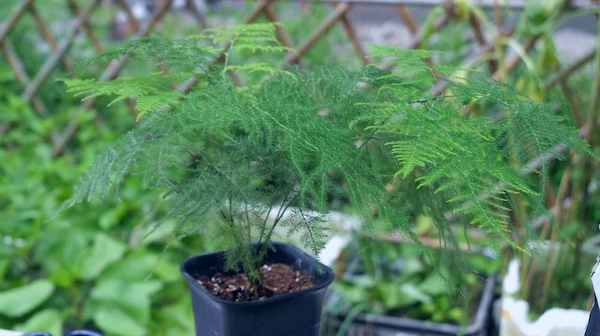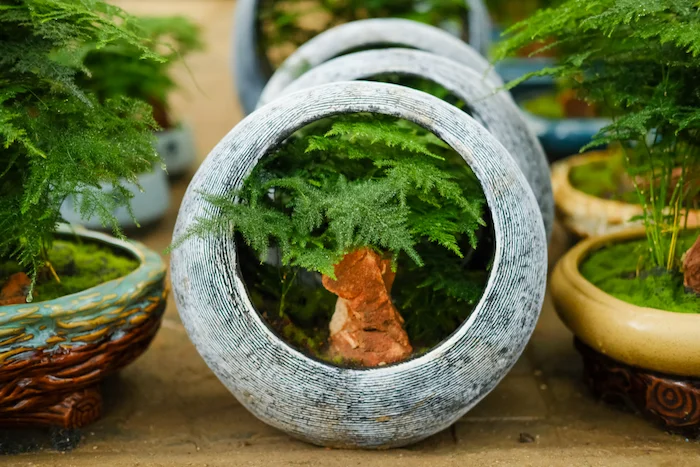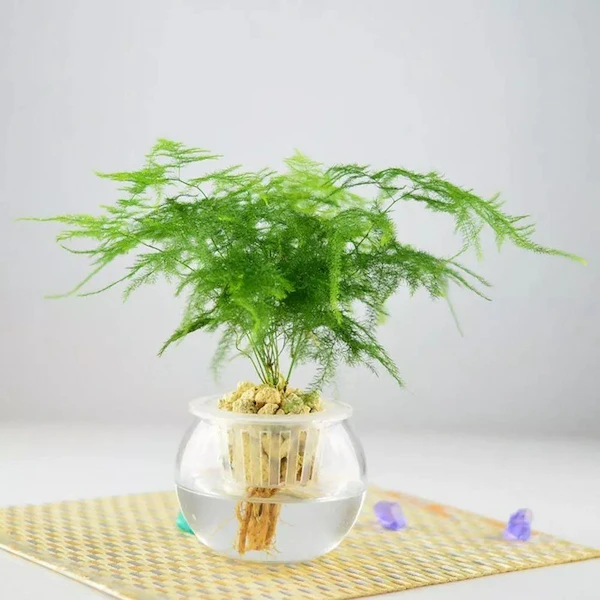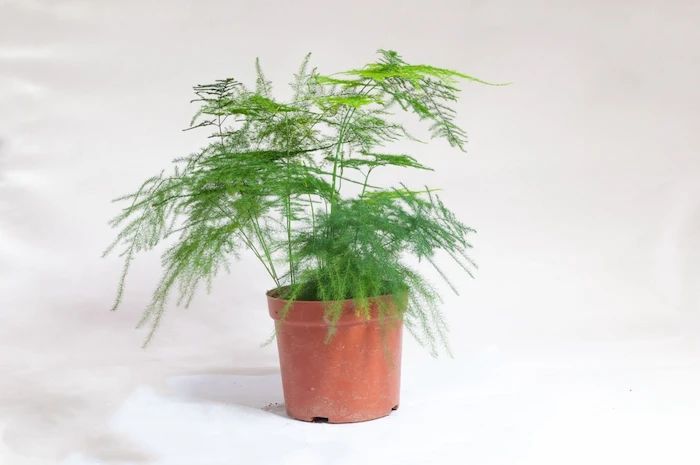How To Grow & Care For Asparagus Fern
Written by Iris
Dec 11 2021

Asparagus Fern is the best indoor plant to tolerate low light and drought. The thick rhizome is an important part of the water retention of Asparagus in Africa. The fine needle-shaped leaves are small, which is very suitable for minimalist and natural home style. Asparagus Fern is native to South Africa and grows in rocks, forests, savanna shrubs and the coast of the Southeast Sea. In the tropics and subtropics, it is a perennial plant that can live as long as 15 years under ideal conditions like asparagus.

Read More:
How Often To Water Asparagus Fern
When you're pruning, consider what shape you want your plant to take on. Do you want a central stem, so that it starts to look like a small tree, or would you rather have the long, feathery branches cascading over the sides of a hanging basket? With this plant, there are many possibilities.
When we repot Asparagus Fern, it's really important to prepare the right soil as the Asparagus Fern likes sandy soil. Clean all soil on Asparagus Fern roots. As the Asparagus Fern is mostly made up of fleshy roots but not capillary roots, so we either wash the soil off or soak it. Do not press the soil as much as possible when repot Asparagus Fern. Water thoroughly so the soil will sink then fill in some soil to let the soil be compacted and the root system would be fully integrated into the soil.
Asparagus Fern is usually repotted in spring and autumn. These two seasons are the most suitable, as the temperature is not very high during the growing season of Asparagus Fern. The hot and sultry summer makes it easy to rot roots after repotting. Winter temperature is low and it is in a non-growing state. After repotting, put it into a cool and ventilated place with a little scattering light. When the Asparagus Fern new leaves and buds start to grow, we can gradually add light to it, return to normal care. (Read more about repotting Asparagus Fern.)
Propagating Asparagus Fern by seed may be challenging, as there are only one to three seeds per berry, and they don't always germinate.
When you're ready to plant your seeds, scrape them gently with sandpaper and soak them in water overnight before sowing. This helps to facilitate germination, by weakening the hard outer coating of the seeds.
If they are too small for you to handle easily, instead of using sandpaper, you could place the seeds in a bag with a little sand and shake them up. Then place the contents of the bag into water, sand and all, to soak for the night.
You may start seeds indoors in egg cartons, seed-starter trays, or grow disks.
Alternatively, you may sow them directly outdoors.
Moisten your potting medium or garden soil, then place the seeds on top and press them down gently. Do not cover the seeds with soil as they need light to germinate.
Place in a location that receives indirect sunlight. Maintain even moisture, watering before the soil dries out completely.
They can take up to four weeks to germinate, so be patient. (Read more about propagating Asparagus Fern from seeds.)
A division is obtained by cutting straight down through a mature plant's rootstock, separating the cut portion, and planting it elsewhere. The Roots Balls are essential, as stems alone will not regrow. (Read more about Fixing Asparagus Fern Roots Ball Rot.)
Place the division into your choice of potting medium or garden soil, and water well.
Maintain even moisture, watering before the soil dries out completely. Then care for the new Asparagus Fern plant carefully.
First of all to select suitable Asparagus Fern plants for cutting, which should be strong enough with lush branches and leaves. Cut a small incision in your chosen branch with a clean knife. After half a day, coat the incision with a layer of bacteria-killing fresh moss and leave it in a moist environment for about 10 days. When you start to see nodules in the incision, you can cut off the branch. All the branches on this asparagus Fern cutting can be cut off except two.
We can make a bag, fill it with moist soil, poke out some small holes in the outside, and then stick the asparagus Fern cutting into about 2 cm, wrapped in cloth outside. Then put it in a big pot and cover it with soil.
Prepare Containers: Before hydroponic, you need to find a good container, clean up then put a small amount of pottery or medical stone at the bottom.
Prune Root: Prepare a plant with roots. If it has dirt soil on root, they need to be cleaned. Comb the roots gently, cutting off any weak roots, leaving only the strong ones.
Hydroponic: When growing Asparagus Fern in water, carefully put the plant in a container and appropriately add some clean water. Do not use dirty water.
Asparagus Fern whole herb and root can be used as medicine. Asparagus Fern root can moisten lung and relieve cough, which can be used in the treatment of tuberculosis, cough phlegm, dysentery.
Ornamental value
Asparagus Fern is a small plant of high ornamental value, which can be used as potted plants, hanging plants and climbing plants. The Asparagus Fern is characterized by its light shape, graceful posture and elegant grace. It is a popular foliage plant in the study room or living room.

If there are definitely no bugs, take a long, hard look at your watering routine. If the Asparagus Fern plant is too wet, the roots will start to rot. The first sign of this is usually yellow leaves at the bottom of the plant. (Read more about solving Asparagus Fern turning yellow.)
Give you plant a spot that's partially shaded and remember to cut it back and split the root ball in spring to keep it under control. Alternatively, you can keep it confined to a stone pot on your patio.
Read Next:
How to Trim an Asparagus Fern?
Is an Asparagus Fern Poisonous to Cats?
How Often to Water Asparagus Fern?
How to Fix Asparagus Fern Roots Ball Rot?
How Much Light Does Asparagus Fern Need?
How to Repot Asparagus Fern?
Can Asparagus Fern Suffer Winter Temperatures?
The Best Potting Soil for Asparagus Fern
How to Grow Asparagus Fern From Seed
How to Grow Asparagus Ferns Indoors or Outdoors
Why Is My Asparagus Fern Turning Yellow - 7 Reason
How To Propagate Common Asparagus Fern
Asparagus Fern Quick InfoHow to Care for Asparagus FernAsparagus Fern Light RequirementsAsparagus Fern Soil CareAsparagus Fern WateringAsparagus Fern Temperature & Humidity CareAsparagus Fern Fertilizer CareAsparagus Fern Pruning CareRepotting Asparagus FernAsparagus Fern Pests & Diseases CareHow to Propagate Asparagus FernGrow Asparagus Fern from SeedsGrow Asparagus Fern from DivisionPropagate Asparagus Fern from CuttingsGrow Asparagus Fern in WaterAsparagus Fern BenefitsAsparagus Fern VarietiesFoxtail FernPlumrose Fern'Sprengeri' Asparagus FernAsparagus Fern FAQWhy is Asparagus Fern turning yellow?Can I grow Asparagus Fern outside?How can I revive Asparagus Fern?Is Asparagus Fern Toxic to Cats and DogsDoes Asparagus Fern BloomIs Asparagus Fern EdibleAsparagus Fern Overwintering
Asparagus Fern Quick Info
| Botanical/Scientific Name | Asparagus aethiopicus syn. Asparagus densiflorus |
| Common Name | common asparagus fern, asparagus grass, lace fern, climbing asparagus, or ferny asparagus |
| Varieties | Foxtail Fern, Plumrose Fern, 'Sprengeri' Asparagus Fern, etc |
| Plant Height | 1 to 3 feet |
| Plant Width | 18 inches to 3 feet wide |
| Growth Rate | Fast |
| Flower | Insignificant white flower |
| Bloom Time | Summer |
| Uses | Foliage plant, climing plant, hanging plant (check best indoor hanging pants here), common indoor plant, outdoor plant |
| Toxic | Safe to human beings but toxic to cats and dogs |
How to Care for Asparagus Fern
Asparagus Fern is a perfect foliage indoor plant as it's always green and quiet. It looks like little bamboo up close, which is elegant. But Asparagus Fern is not very easy to care for. Of course, there are some masters of the Asparagus Fern, who kept the Asparagus Fern so tall all year round that some even blossomed. So let's take a look at how to care for Asparagus Fern.
Asparagus Fern Light Requirements
Asparagus ferns like bright indirect light. Too much hot sun can scorch their leaves, too little will cause it to yellow and drop needles. You can take 2 approaches when placing your asparagus ferns. (Read more about Asparagus Fern Light Requirements.)- Place directly in an east-facing window. It will love that soft morning sun. A north window MAY be enough light but just keep an eye on it and if it's looking sad, move it too a brighter locale.
- Place it to the side of or a few feet back from south or west-facing window. This is where indirect becomes important. These windows will get afternoon and evening sun which is very hot, especially in summer, and it can burn your Asparagus Fern plant. (Read more about growing Asparagus Fern indoors or outdoors.)
Asparagus Fern Soil Care
The key to the success of growing an Asparagus fern is a fast-draining soil. There are a couple of ways to do this: Mix 1 part potting soil with one part perlite. While potting soil generally has perlite in it, we want to add more to increase aeration and improve drainage. Asparagus ferns also like loamy soil. You can make this by mixing 20% clay, 40% sand and 40% silt. (Read more about best potting soil for Asparagus Fern.)Asparagus Fern Watering
An Asparagus Fern is a thirsty plant which means you may have to water it more often than your other plants. Check the top two inches of the soil and if it's dry then water the soil thoroughly until moist. Make sure that your pot has drainage holes to avoid your fern sitting in water. Brown fronds can be an indication of too little water. Check on your Asparagus Fern more often than your other plants until you understand how often it needs to be watered in your home. You may find it’s once a week but if you live somewhere hotter and drier then it could be more often.Read More:
How Often To Water Asparagus Fern

Asparagus Fern Temperature & Humidity Care
This Asparagus Fern houseplant will grow happily in temperatures of 12-25°C, try to avoid sudden drops in temperature and be wary of draughts and open windows. If you can provide your Asparagus Fern with a more humid environment then your plant will thrive. If you live in a drier climate then you could consider buying a humidifier. And if you don’t want to invest in one of those then misting your plants once a day or once every other day should do the trick. Another way to increase humidity for your Asparagus Fern is to place your plant in a pebbled tray full of water so as the water evaporates, the moisture will be taking in by your leaves. (Read more about whether Asparagus Fern can suffer winter temperatures.)Asparagus Fern Fertilizer Care
Fertilize an asparagus fern weekly during the summer with a water-soluble fertilizer. Feed monthly during the rest of the year. Always dilute the fertilizer to 1/2 the recommended strength.Asparagus Fern Pruning Care
Be radical when you're trimming Asparagus Fern plant. Removing an old branch completely will encourage several fresh branches to grow, but snipping the tip from a branch will stop it from growing at all.When you're pruning, consider what shape you want your plant to take on. Do you want a central stem, so that it starts to look like a small tree, or would you rather have the long, feathery branches cascading over the sides of a hanging basket? With this plant, there are many possibilities.
Repotting Asparagus Fern
The Asparagus Fern has an exquisite shape and is usually grown as a potted plant. The soil in the small pot is low in nutrients, so it is necessary to repot Asparagus Fern every one year or one and a half year, otherwise the leaves would turn yellow due to lack of nutrients. So how to repot Asparagus Fern?When we repot Asparagus Fern, it's really important to prepare the right soil as the Asparagus Fern likes sandy soil. Clean all soil on Asparagus Fern roots. As the Asparagus Fern is mostly made up of fleshy roots but not capillary roots, so we either wash the soil off or soak it. Do not press the soil as much as possible when repot Asparagus Fern. Water thoroughly so the soil will sink then fill in some soil to let the soil be compacted and the root system would be fully integrated into the soil.
Asparagus Fern is usually repotted in spring and autumn. These two seasons are the most suitable, as the temperature is not very high during the growing season of Asparagus Fern. The hot and sultry summer makes it easy to rot roots after repotting. Winter temperature is low and it is in a non-growing state. After repotting, put it into a cool and ventilated place with a little scattering light. When the Asparagus Fern new leaves and buds start to grow, we can gradually add light to it, return to normal care. (Read more about repotting Asparagus Fern.)
Asparagus Fern Pests & Diseases Care
Spider mites, aphids, and mealybugs like to hang out in this plant's leaves, get rid of them with insecticidal soap. Overly wet conditions can cause root-rot.How to Propagate Asparagus Fern
Grow Asparagus Fern from Seeds
Asparagus Fern Seeds may be purchased, or you can opt to save your own.Propagating Asparagus Fern by seed may be challenging, as there are only one to three seeds per berry, and they don't always germinate.
When you're ready to plant your seeds, scrape them gently with sandpaper and soak them in water overnight before sowing. This helps to facilitate germination, by weakening the hard outer coating of the seeds.
If they are too small for you to handle easily, instead of using sandpaper, you could place the seeds in a bag with a little sand and shake them up. Then place the contents of the bag into water, sand and all, to soak for the night.
You may start seeds indoors in egg cartons, seed-starter trays, or grow disks.
Alternatively, you may sow them directly outdoors.
Moisten your potting medium or garden soil, then place the seeds on top and press them down gently. Do not cover the seeds with soil as they need light to germinate.
Place in a location that receives indirect sunlight. Maintain even moisture, watering before the soil dries out completely.
They can take up to four weeks to germinate, so be patient. (Read more about propagating Asparagus Fern from seeds.)
Grow Asparagus Fern from Division
To grow Asparagus Ferns by division propagation, consult our guide to dividing perennials.A division is obtained by cutting straight down through a mature plant's rootstock, separating the cut portion, and planting it elsewhere. The Roots Balls are essential, as stems alone will not regrow. (Read more about Fixing Asparagus Fern Roots Ball Rot.)
Place the division into your choice of potting medium or garden soil, and water well.
Maintain even moisture, watering before the soil dries out completely. Then care for the new Asparagus Fern plant carefully.
Propagate Asparagus Fern from Cuttings
Propagating Asparagus Fern from cuttings can be done all time of year, but it may not easily survive if temperatures are too low. The temperature requires between 20 and 30 degrees Celsius.First of all to select suitable Asparagus Fern plants for cutting, which should be strong enough with lush branches and leaves. Cut a small incision in your chosen branch with a clean knife. After half a day, coat the incision with a layer of bacteria-killing fresh moss and leave it in a moist environment for about 10 days. When you start to see nodules in the incision, you can cut off the branch. All the branches on this asparagus Fern cutting can be cut off except two.
We can make a bag, fill it with moist soil, poke out some small holes in the outside, and then stick the asparagus Fern cutting into about 2 cm, wrapped in cloth outside. Then put it in a big pot and cover it with soil.
Grow Asparagus Fern in Water
Asparagus Fern can grow in water as well as in soil. Not only does it grow in water, but it's also easy to care for, and it lives quickly. However, it is not advisable to simply cut a branch off the plant and place it in water.Prepare Containers: Before hydroponic, you need to find a good container, clean up then put a small amount of pottery or medical stone at the bottom.
Prune Root: Prepare a plant with roots. If it has dirt soil on root, they need to be cleaned. Comb the roots gently, cutting off any weak roots, leaving only the strong ones.
Hydroponic: When growing Asparagus Fern in water, carefully put the plant in a container and appropriately add some clean water. Do not use dirty water.
Asparagus Fern Benefits
Medical ValueAsparagus Fern whole herb and root can be used as medicine. Asparagus Fern root can moisten lung and relieve cough, which can be used in the treatment of tuberculosis, cough phlegm, dysentery.
Ornamental value
Asparagus Fern is a small plant of high ornamental value, which can be used as potted plants, hanging plants and climbing plants. The Asparagus Fern is characterized by its light shape, graceful posture and elegant grace. It is a popular foliage plant in the study room or living room.
Asparagus Fern Varieties
Foxtail Fern
Foxtail Fern - Asparagus densiflorus 'Myers' has dense, bottle-brush-like stems that grow more upright. It makes a better tabletop plant than a hanging basket.Plumrose Fern
Plumrose Fern - Asparagus setaceus looks the most like a true fern. The spreading layered stems are covered with tiny soft needles. Older stems can grow several feet long. Cut them back to promote denser growth.'Sprengeri' Asparagus Fern
'Sprengeri' Asparagus Fern - Asparagus densiflorus 'Sprengeri', the most widely available variety, has arching stems with 1-inch-long dark green needles.
Asparagus Fern FAQ
Why is Asparagus Fern turning yellow?
The most common reasons for the Asparagus Fern plant turning yellow are pests and overwatering. Because they can be so damaging and so hard to eradicate, check for insects first. In fact, you should probably scan your plant for signs of an infestation every time you water it.If there are definitely no bugs, take a long, hard look at your watering routine. If the Asparagus Fern plant is too wet, the roots will start to rot. The first sign of this is usually yellow leaves at the bottom of the plant. (Read more about solving Asparagus Fern turning yellow.)
Can I grow Asparagus Fern outside?
If you live in a warm climate, the asparagus fern will survive outside. But you should be careful. There are many parts of the world where it's considered an invasive weed because, once it's planted, it's hard to get rid of.Give you plant a spot that's partially shaded and remember to cut it back and split the root ball in spring to keep it under control. Alternatively, you can keep it confined to a stone pot on your patio.
How can I revive Asparagus Fern?
Growers love the asparagus fern because it can be revived even if it looks like it's at death's door. You may have to give it a radical haircut because the leaves themselves won't come back to life, but never throw this plant away unless it's summer and you're still not seeing any growth. If it dries out completely, give it a good drink and wait. Once new growth appears, fertilize it and hope for the best.Is Asparagus Fern Toxic to Cats and Dogs
The Asparagus Fern is non-toxic to humans, but cats and dogs can easily ingest it and cause serious toxic reactions. Asparagus Fern contains a lot of saponins and colchicines, which can be toxic to cats and dogs, even cause death. As a result, Asparagus Fern is not recommended for homes with pets. (Read more about what if Cats eat Asparagus Fern.)Does Asparagus Fern Bloom
Asparagus Fern is a perennial herb whose flowers are small and white in color. However, it needs better conditions for flowering, generally, it is difficult to bloom if growing indoors.Is Asparagus Fern Edible
Asparagus Fern is not edible, but it can be used as medicineAsparagus Fern Overwintering
Asparagus Fern is not cold tolerant and needs to be kept indoors during the winter, preferably above 15℃. Watering should be properly controlled and can be watered once in half a month. It will not be frozen to death under reasonable care in winter.Read Next:
How to Trim an Asparagus Fern?
Is an Asparagus Fern Poisonous to Cats?
How Often to Water Asparagus Fern?
How to Fix Asparagus Fern Roots Ball Rot?
How Much Light Does Asparagus Fern Need?
How to Repot Asparagus Fern?
Can Asparagus Fern Suffer Winter Temperatures?
The Best Potting Soil for Asparagus Fern
How to Grow Asparagus Fern From Seed
How to Grow Asparagus Ferns Indoors or Outdoors
Why Is My Asparagus Fern Turning Yellow - 7 Reason
How To Propagate Common Asparagus Fern
Latest Updated
- Benefits of Bugleweed - 7 Science-backed Health Benefits
- Bugleweed Dangers & Side Effects - Is It Poisonous?
- How to Plant Evergreen Trees - What You Should Know
- When to Plant Evergreens - Grow Guide for Evergreen Trees
- 12 Wonderful Evergreen Shrubs for Your Garden
- 12 Popular Evergreen Plants with Pictures for Beginners
- When And How To Prune A Lilac Bush Like a Pro
- How to Grow & Care for Lilac Vine (Hardenbergia Violacea)
- Japanese Lilac Tree (Syringa Reticulata) Care & Propagation Guide
- Shumard Oak Pros and Cons - What to Know
Popular Articles
- Winter maintenance of Antirrhinum Majus
- How to Grow Terminalia Mantaly Tree
- How to Grow and Care for Crossostephium Chinense
- How to grow Antirrhinum Majus in spring
- Peristeria Elata (Dove Orchid) Profile: Info & Care Guide
- Underwatered Snake Plant (Sansevieria Trifasciata) - Signs And How To Fix
- How to Care for Brazilian Jasmine Plant (Mandevilla Sanderi)
- How to Grow & Care for Graptopetalum Purple Delight in Summer
- Rosa Chinensis (China Rose): Plant Growing & Care Tips
- How to Care for Baby Sun Rose (Aptenia Cordifolia)
